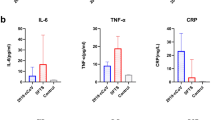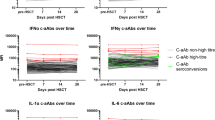Abstract
Patterns of C-reactive protein (CRP) release were derived from frequent CRP measurements in a cohort of 66 consecutive patients receiving allogeneic bone marrow transplants (BMT) in our unit. Based on a retrospective study of clinical events occurring within the first 40 days after BMT, patients with major transplant-related complications (MTC+ group, n = 22) could be separated from those with fever or mild complications only (MTC− group, n = 44). Treatment-related mortality in the MTC+ group was significantly higher: 32 vs 0% (P < 0.001). major complications included veno-occlusive liver disease (vod), severe endothelial leakage syndrome (els), pneumonitis and acute gvhd >II. The severity of complications was reflected by the patterns of CRP release with continuously high levels preceding the maximal signs and symptoms of MTC. Univariate analysis showed that, among other variables (sex, age, disease status at transplant, ±TBI in the conditioning regimen, ± use of myeloid growth factors after BMT, time to reach PN >200/mm3), three factors were significantly associated with MTC: maximal levels of CRP during the post-transplant episode (CRPmax) (296.6 ± 91.8 vs 88.9 ± 55.8 mg/100 ml, P < 0.001), the use of unmanipulated graft (no t depletion) (46.9 vs 12.5%, P < 0.009) and the crp level on the day of bmt (crpo) (42.7 ± 55.4 vs 18.2 ± 19.5, P = 0.045). In multivariate analysis, using a stepwise logistic regression model including the same variables, CRPmax appeared to be the strongest independent variable (P < 0.001) and a reliable (94% accuracy) parameter to assess the risk of mtc. based on this model, crp levels of 200 and 300 mg/100 ml are associated with a risk of 48 and 94% of developing mtc, respectively. we conclude that crp monitoring after bmt identifies patients at risk of severe transplant-related complications and mortality.
This is a preview of subscription content, access via your institution
Access options
Subscribe to this journal
Receive 12 print issues and online access
$259.00 per year
only $21.58 per issue
Buy this article
- Purchase on Springer Link
- Instant access to full article PDF
Prices may be subject to local taxes which are calculated during checkout
Similar content being viewed by others

Author information
Authors and Affiliations
Rights and permissions
About this article
Cite this article
Schots, R., Kaufman, L., Van Riet, I. et al. Monitoring of C-reactive protein after allogeneic bone marrow transplantation identifies patients at risk of severe transplant-related complications and mortality. Bone Marrow Transplant 22, 79–85 (1998). https://doi.org/10.1038/sj.bmt.1701286
Received:
Accepted:
Published:
Issue Date:
DOI: https://doi.org/10.1038/sj.bmt.1701286
Keywords
This article is cited by
-
Net reclassification improvement with serial biomarkers and bed-sided spirometry to early predict the need of organ support during the early post-transplantation in-hospital stay in allogeneic HCT recipients
Bone Marrow Transplantation (2019)
-
Kinetics of inflammatory biomarkers in plasma predict the occurrence and features of cytomegalovirus DNAemia episodes in allogeneic hematopoietic stem cell transplant recipients
Medical Microbiology and Immunology (2019)
-
Patterns of infection and infection-related mortality in patients with steroid-refractory acute graft versus host disease
Bone Marrow Transplantation (2017)
-
Inflammatory Markers in Patients after Hematopoietic Stem Cell Transplantation
Archivum Immunologiae et Therapiae Experimentalis (2013)
-
Clinical laboratory markers of inflammation as determinants of chronic graft-versus-host disease activity and NIH global severity
Leukemia (2012)


